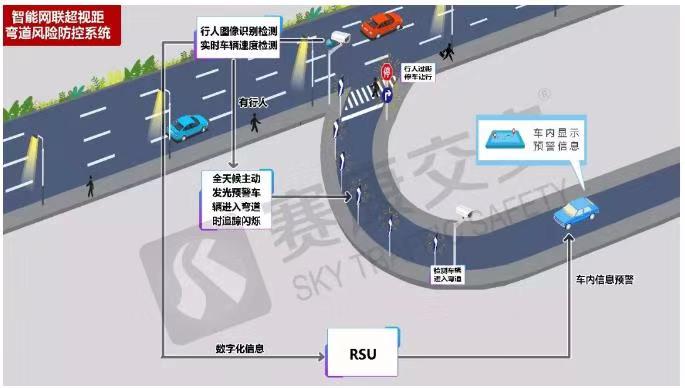On September 7, CCTV 13 news broadcasting studio reported that "the first pilot area of vehicle network in Wuxi, Jiangsu Province was unveiled". The scene of cooperation between vehicles and vehicles, vehicles and people, vehicles and roads, vehicles and service platforms has become a hot spot. Among them, the "active and intelligent" series of road scenarios jointly created by China Mobile, Ministry of Public Security Traffic Office, Wuxi Traffic Police, Huawei, Tian'an Zhilian, Saikang Jiaoan and other units of the strategic partners of the project team of the National Pilot Area of Vehicle Networking, are on the road of achievement promotion through demonstration application. China Road Traffic Safety Think Tank Committee Wechat Public Number has released scenario plans successively, Intelligent Network Over-the-horizon Bend Risk Prevention and Control System.

1. Safety Pain Points at Curve Intersection
Bends, especially those on freeways, on-ramps of expressways and on-ramps of expressways, as well as those on road traffic hubs, are often accompanied by gradients, trees and intersecting roads, which are characterized by high-risk environment with high incidence of traffic accidents. The traditional method is to install speed limit, induced reflective signs and mark lines to guide the safe passage of vehicles. The main risks of traffic accidents are as follows: first, the relationship between the trajectory and turning radius depends on the driver's perception, which can easily lead to manipulation errors; second, the distance of the blind area in front of the vehicle is relatively short, and it is difficult to identify unexpected events or complex road conditions; third, the pedestrians and vehicles on the intersecting road in front of the vehicle have "ghost probe" characteristics. Fourthly, the illumination signs of vehicles are insufficient because of the influence of angle, slope and weather visibility.
2. Introduce the scheme of risk prevention and control system for over-the-horizon bend in Intelligent Network
System components: Huawei C-V2X RSU (Road Side Unit) dual-mode roadside unit + Saikon I2V linear guidance sign + I2V stop sign + all-weather video image recognition device + screen display broadcaster + speed radar.
The working principle of the system
(1) The system detects vehicles entering curves:
a. The system control chip sends instructions to the corresponding devices with the linear guidance signs of sensors, opens the panel to display the active light-emitting working state, and traces the flicker to provide the driver with the perception of road boundary contour and decelerate driving.
b. The system control chip sends instructions to the screen-displayed voice broadcaster at the plane intersection of the front end of the bend, and knows pedestrians or non-motorized vehicles through jumping subtitles and voice broadcasting reports. Cars come to the bend and pay attention to avoidance.
(2) The system detects that pedestrians and non-motorized vehicles will enter or are passing through the front-end plane of the bend:
a. Event information is sent to on-board OBU (On Board Unit) equipment through RSU, so as to realize active notification and prompt the vehicle to decelerate automatically or the driver to stop and give way actively.
b. The system control chip sends instructions to the corresponding devices with sensor stop sign, opens the panel to display the active light-emitting working state, and flickers at high frequency, requiring the vehicle to stop and give way.
(3) Vehicles that may be out of control at extra (super) speed detected by speed radar:
Event information is sent to on board OBU (On Board Unit) equipment in adjacent space through RSU, which can realize active notification to make the vehicle decelerate automatically or the driver decelerate actively until safe avoidance.
(4) The whole event information transmission process is recorded in real time on the cloud platform, which can also know the working status of the whole system facilities in real time.
3. Functional Advantages of Intelligent Network Linked Over-the-horizon Bend Risk Prevention and Control System
(1) Sentinel-type automatic pedestrian and vehicle detection devices are installed to realize "beyond visual range" information in blind areas or under the condition of insufficient visual distance.
(2) The integration of networking, chip, sensing, image recognition, data operation and all-weather visualization under the condition of the new generation of communication technology is stable and reliable.
(3) In a complex interactive space, data interaction among vehicles, roads, pedestrians and environments is formed, real-time online, and protocols are mutually concessional.
(4) The panel display active luminescence technology solves the dependence on the information of vehicle lighting visual recognition signs and improves the safe visual distance.
(5) Active measures to prevent traffic accidents in such high-risk sections.


